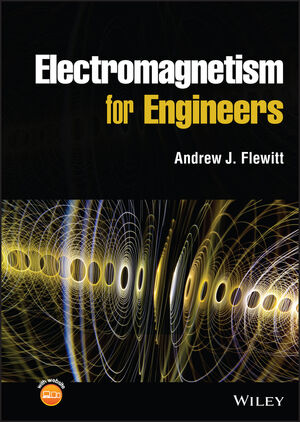
Professor Andrew Flewitt’s book ‘Electromagnetism for Engineers’ is aimed at undergraduate students studying electrical engineering or physics in the first couple of years of their course.
Many text books about electromagnetism are written from a heavy physics perspective so they can be quite off-putting and easy to get bogged down in a lot of detail. My book tries to cut through this.
Professor Andrew Flewitt
Earlier this year saw the accompanying set of 48 questions along with videos of Andrew going through model answers go live on Wiley's website, accompanying the book as a completely free, open access resource to everyone.
He says, “I hope that this is really useful both for students and also for anyone teaching electromagnetism at university, and if you like the free online material, do consider checking out the book too.”
Andrew wrote the book having spent 20 years supervising and lecturing on electromagnetism to undergraduate students studying Engineering at Cambridge University.
He says, “Students often get put off this subject because they think it’s very complicated. I have tried to present things in a consistent and straightforward way while also showing the beauty in the subject and how it makes so much of our modern life possible. It’s divided into two parts. The first focuses on fundamentals of fields, their origins and effects. The second looks at applications, including transmission lines, antennas, waves in dielectric and conducting media, waveguides and three-phase power.
“Many text books about electromagnetism are written from a heavy physics perspective so they can be quite off-putting and easy to get bogged down in a lot of detail. My book tries to cut through this. I have greatly enjoyed writing the book, which I hope comes over in the text.”
An easily accessible textbook to introduce the power of electromagnetism.
Electromagnetism can be a difficult subject to grasp and to teach. Much of what we take for granted in modern life is enabled by electromagnetic effects, but it isn’t always easy to understand the impact of electromagnetism compared to other areas of engineering, such as mechanics, which are more tangibly observed and felt.
Although electromagnetism is a crucial and important branch of physics with elegant mathematics, many students can find the study of electromagnetism inaccessible.
It is crucial for students of electrical and electronic engineering and physics to have a strong understanding of electromagnetism and how it impacts communications, power generation and transmission, semiconductor devices, motors, and more.
Electromagnetism for Engineers aims to develop a student’s understanding of electromagnetism in the context of real effects and how they apply to such applications, whilst maintaining the sophistication of the mathematics that can be used to give deeper insight.
It begins by describing the fundamentals of electromagnetism before a more detailed discussion of the basic concepts developed for specific application areas. It then considers the application of electromagnetism to transmission lines, antennas, and waveguides.
Electromagnetism for Engineers readers will find:
- A unique approach that illustrates the link between real-life applications and fundamental theory of electromagnetism
- Clear, concise language to help students gain a full understanding of the subject.
- Carefully designed figures to illustrate points throughout the book.
- Accompanying website.
Electromagnetism for Engineers has been written as a textbook for undergraduates studying electronic or electrical engineering. It can also be of interest to physics students and to graduate-level students looking for a general book on electromagnetism. It is also a useful reference for professional engineers looking for a refresher on the fundamentals of electromagnetism.
Andrew J. Flewitt, PhD CEng, is Professor of Electronic Engineering at Cambridge University, Department of Engineering, and Head of the Electrical Engineering Division. He graduated in Physics from the University of Birmingham, UK, before moving to Cambridge to carry out a PhD in Engineering investigating the growth of hydrogenated amorphous silicon thin films using scanning tunnelling microscopy. He was first appointed to a Lectureship in 2002, and his current research interests encompass both large-area electronics and microelectromechanical systems. He is a Member of the Institute of Physics, a Member of the Institution of Engineering and Technology, and is a Chartered Engineer.


